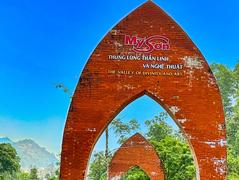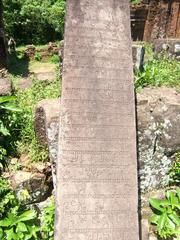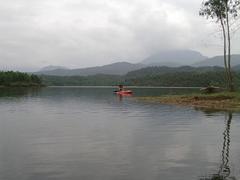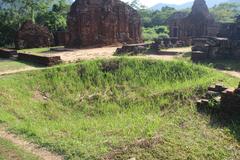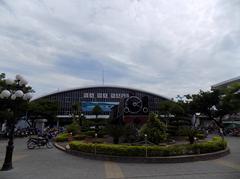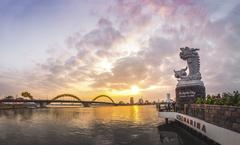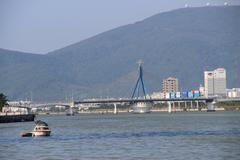
Mỹ Sơn Sanctuary: Visiting Hours, Tickets, and Historical Sites in Đà Nẵng
Date: 14/06/2025
Introduction: The Cultural Significance of Mỹ Sơn Sanctuary
Nestled in the lush valleys of Quảng Nam Province near Đà Nẵng, Mỹ Sơn Sanctuary is an extraordinary testament to the enduring spiritual and artistic legacy of the ancient Champa Kingdom. Recognized as a UNESCO World Heritage Site, Mỹ Sơn comprises a complex of over 70 Hindu temple ruins, primarily dedicated to Shiva—locally known as Bhadreshvara. The site’s intricate red-brick architecture and evocative stone carvings showcase a unique blend of Indian Hindu influences and indigenous Cham artistry. For history enthusiasts, cultural explorers, and photographers alike, Mỹ Sơn offers a captivating journey into Southeast Asia’s spiritual heritage.
This comprehensive guide provides essential information on visiting hours, ticketing, practical travel tips, and detailed insights into the sanctuary’s cultural and architectural significance. You’ll also find recommendations for nearby attractions to enrich your Vietnamese heritage experience. By understanding Mỹ Sơn’s historical context and preservation efforts, you’ll gain a deeper appreciation of this remarkable destination (archaeolist.com, vietnamdrive.com, smarthistory.org, Wikipedia).
Table of Contents
- Introduction
- Historical Background
- Visiting Mỹ Sơn Sanctuary
- Artistic and Architectural Features
- Inscriptions and Records
- Preservation and Legacy
- Frequently Asked Questions (FAQ)
- Conclusion
- References
Historical Background
Origins and Early Development
Founded in the late 4th century CE by King Bhadravarman I, Mỹ Sơn was established as the spiritual heart of the Champa Kingdom (archaeolist.com). The earliest temples, initially constructed of wood, were strategically placed in a secluded valley surrounded by mountains for both protection and sanctity (vietnamtour.com.vn).
Religious and Cultural Importance
Mỹ Sơn served as the sacred venue for royal ceremonies such as coronations and baptisms, closely tied to the political legitimacy of Champa rulers. The temples primarily honor Shiva, represented by the linga-yoni, and also feature shrines to Vishnu and Brahma, reflecting a blend of Indian and local Cham religious traditions (smarthistory.org).
Architectural Evolution
Over nearly a millennium (4th–13th centuries CE), Mỹ Sơn’s architecture transitioned from wood to sophisticated red brick and sandstone temples. The buildings are grouped into clusters (A, B, C, D, E, G), each reflecting distinctive Cham styles such as Ancient, Hoa Lai, Dong Duong, and Mỹ Sơn–Bình Định (vietnamdrive.com). Notable was the 24-meter-high tower in the Tháp Chùa area, a masterpiece before its destruction during the Vietnam War (vietnamtour.com.vn).
Key Historical Events
Mỹ Sơn flourished as Champa’s religious and political center from the 4th to 10th centuries, but pressures from Đại Việt and Khmer empires led to its decline by the 15th century (archaeolist.com). Rediscovered by French explorers in 1885, the site has since been the focus of extensive archaeological research and restoration, despite significant war damage (smarthistory.org).
Visiting Mỹ Sơn Sanctuary
Visiting Hours
- Opening Hours: 6:00 AM – 5:00 PM daily (including holidays)
- Last Entry: 4:00 PM
- Early morning visits are recommended for cooler temperatures and fewer crowds, especially during peak season.
Ticket Information
- Entrance Fee: 150,000 VND (approx. $6.70 USD) per adult (as of 2025)
- Children under 15: Free
- Tickets include access to the sanctuary, on-site museum, and an electric shuttle ride from the entrance to the main ruins.
Tickets can be purchased at the entrance or through authorized online platforms. Guided tours frequently include ticket fees.
Guided Tours and Accessibility
- Guided Tours: Available onsite and via travel agencies; English-speaking guides can be hired at the entrance for 100,000–200,000 VND ($4–$8 USD) per group.
- Accessibility: The sanctuary features paved paths and ramps in certain areas, but uneven terrain and steps make access challenging for visitors with limited mobility. Electric shuttles reduce walking distances, but some temple clusters may remain less accessible.
Travel Tips
- Dress Code: Wear modest clothing that covers shoulders and knees; lightweight fabrics are best for the heat.
- Footwear: Comfortable, sturdy walking shoes are essential for uneven terrain.
- Essentials: Bring sun protection (hat, sunscreen), water, and insect repellent.
- Photography: Personal photography and tripods are allowed; drone use requires prior permission.
Nearby Attractions
- Hội An Ancient Town: A UNESCO World Heritage Site, easily combined with a Mỹ Sơn trip.
- Cham Museum (Đà Nẵng): Houses a rich collection of Cham sculptures.
- Marble Mountains: Scenic limestone peaks with caves and temples near Đà Nẵng.
Artistic and Architectural Features
Mỹ Sơn’s temples are renowned for their red brick construction and intricate bas-reliefs depicting mythological creatures (makara, garuda, lions, elephants) and divine figures like apsaras and Shiva (vietnamdrive.com). The temple layout reflects Hindu cosmology, with clusters oriented eastward to welcome the morning sun. The linga-yoni sanctuaries at the heart of each group symbolize Shiva’s creative power.
Inscriptions and Records
Stone stelae inscribed in Sanskrit and Cham document the site’s history, temple dedications, royal decrees, and religious practices, offering valuable insights into Champa’s civilization (archaeolist.com).
Preservation and Legacy
Despite suffering damage from war and natural decay, Mỹ Sơn has been the focus of ongoing conservation efforts by the Vietnamese government and international partners, including the Archaeological Survey of India (smarthistory.org). The site’s UNESCO World Heritage status since 1999 underscores its global significance and the importance of sustainable tourism.
Frequently Asked Questions (FAQ)
Q: What are Mỹ Sơn’s visiting hours?
A: The sanctuary is open daily from 6:00 AM to 5:00 PM; last entry at 4:00 PM.
Q: How much is the entrance fee?
A: 150,000 VND (approx. $6.70 USD) per adult; free for children under 15.
Q: Are guided tours available?
A: Yes, guides can be hired at the entrance or through organized tours.
Q: Is Mỹ Sơn wheelchair accessible?
A: Accessibility is limited due to uneven terrain and steps, but electric shuttles help reduce walking distances.
Q: What is the best time to visit?
A: Early mornings during the dry season (March–May) for pleasant weather and fewer visitors.
Q: Can I use a drone?
A: Drone use is generally prohibited without permission from site management.
Q: What other attractions are nearby?
A: Hội An Ancient Town, Cham Museum in Đà Nẵng, and Marble Mountains.
Conclusion
Mỹ Sơn Sanctuary is a captivating destination that illuminates the spiritual life and architectural ingenuity of the Champa Kingdom. From its origins as a sacred Hindu site to its status as a vibrant center of Cham culture, Mỹ Sơn offers a profound connection to Vietnam’s rich past. With practical information on visiting hours, ticketing, accessibility, and nearby attractions, travelers can enjoy a memorable and respectful experience. By adhering to preservation guidelines and embracing the site’s cultural heritage, every visitor helps safeguard this treasure for future generations.
For more travel guides and updates on Vietnam’s historical landmarks, download the Audiala app and follow our related posts on Quảng Nam’s heritage sites.
References
- Mỹ Sơn Sanctuary: Visiting Hours, Tickets, and Historical Guide to Quảng Nam’s Ancient Hindu Temples, 2025, Archaeolist (archaeolist.com)
- Mỹ Sơn Sanctuary Overview, 2025, Vietnam Drive (vietnamdrive.com)
- Mỹ Sơn Hindu Temple Complex, 2025, Smarthistory (smarthistory.org)
- Mỹ Sơn Sanctuary, 2025, Vietnam Tour (vietnamtour.com.vn)
- Mỹ Sơn Sanctuary, 2025, Wikipedia (Wikipedia)
- Exploring the Legend of Mỹ Sơn Sanctuary, 2025, Chieu Tour (chieutour.com)
- Mỹ Sơn Sanctuary World Cultural Heritage, 2025, Danang Leisure (danangleisure.com)
- Explore Global Cultural and Historical Values at Mỹ Sơn Sanctuary, 2025, Vietnam Travel (vietnam.travel)
